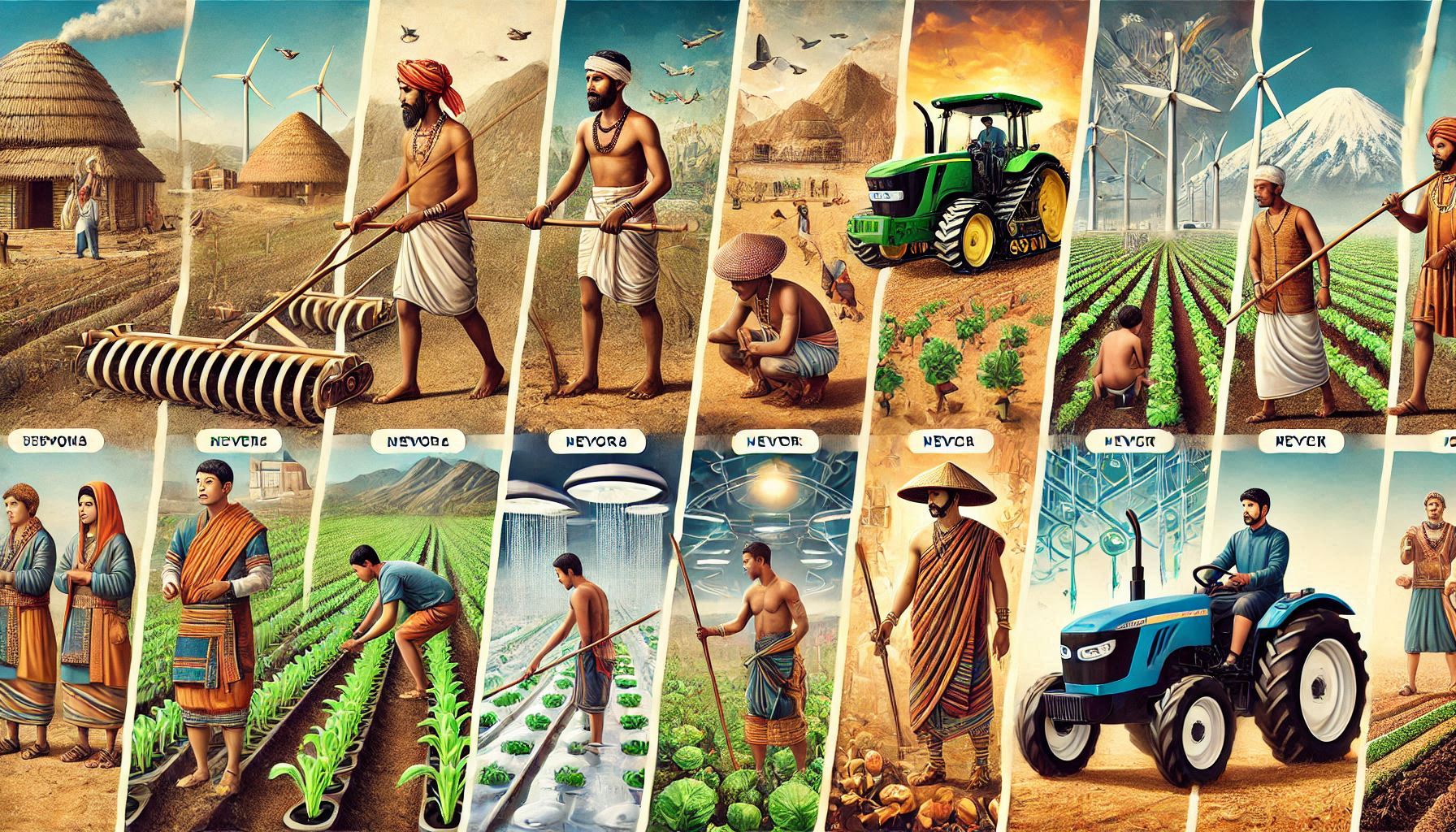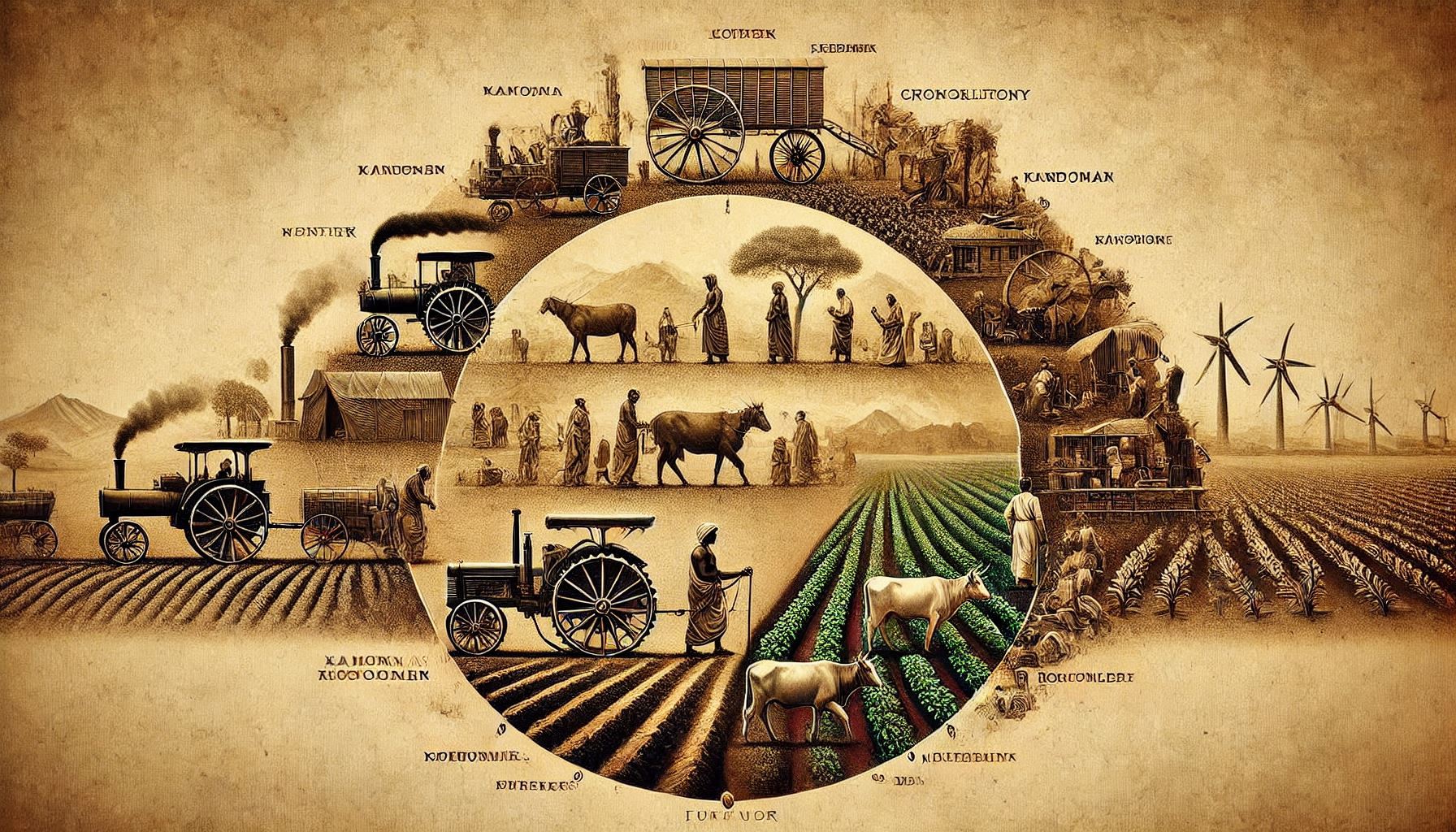History of agricultural development in the world and India. Agriculture heritage – Agriculture in ancient India One Liner
History of Agricultural Development:
- Agriculture originated around 12,000 years ago with the domestication of plants and animals.
- The first evidence of agriculture appeared in the Fertile Crescent of the Near East.
- Early agricultural practices were based on wild grain harvesting.
- The Neolithic Revolution marked the shift from hunter-gatherer societies to settled farming communities.
- The domestication of wheat, barley, and legumes began in the Near East.
- Egypt, Mesopotamia, and the Indus Valley were among the earliest cradles of agriculture.
- Ancient Egypt developed irrigation techniques along the Nile River to sustain agriculture.
- The plow, one of the earliest tools, was developed in the Near East.
- Bronze tools appeared around 3000 BC, enhancing agricultural productivity.
- The use of irrigation expanded in early civilizations to control water supply and increase crop yields.
- The Indus Valley civilization excelled in agriculture with systems of irrigation and urban farming.
- In China, rice and millet became staple crops as early as 7000 BC.
- Mesoamerican civilizations domesticated maize, beans, and squash around 2000 BC.
- The first forms of crop rotation appeared in ancient civilizations to maintain soil fertility.
- Roman agriculture relied heavily on slave labor for large-scale farming operations.
- Medieval Europe saw the introduction of the three-field crop rotation system.
- The Islamic Golden Age contributed advancements in agricultural knowledge, including crop rotation and irrigation.
- The introduction of the horse collar in medieval Europe revolutionized plowing.
- The Agricultural Revolution in England (17th-19th centuries) led to improved crop yields and farming techniques.
- The invention of the seed drill by Jethro Tull in 1701 greatly enhanced crop planting efficiency.
- The Industrial Revolution facilitated large-scale mechanization of farming.
- Modern agricultural practices have led to higher yields through the use of synthetic fertilizers and pesticides.
- The Green Revolution in the mid-20th century introduced high-yield crop varieties and improved irrigation methods.
- Biotechnology has contributed to genetic modifications in crops, increasing resistance to diseases.
- The rise of organic farming emphasizes sustainable practices and environmental preservation.
Agriculture in Ancient India:
- Agriculture in India dates back to the Neolithic age (7500-6500 BC).
- The earliest evidence of agriculture in India comes from the Harappan civilization.
- The Indus Valley civilization practiced advanced agricultural techniques including irrigation and crop rotation.
- The Rigveda mentions more than 75 plant species, reflecting early agricultural knowledge.
- Ancient Indian agriculture was influenced by religious practices and rituals.
- Kautilya’s Arthashastra discusses farming techniques, cattle rearing, and agricultural economy.
- The famous “Cow Sukta” in the Rigveda highlights the importance of cows in rural economy.
- Ancient Indian farmers used plows made of wood and oxen for cultivation.
- Manusmriti emphasizes the importance of agriculture for the economy and society.
- Ancient Indians cultivated a variety of crops including wheat, barley, rice, and cotton.
- Irrigation techniques in ancient India included wells, canals, and tanks.
- Agricultural practices were closely tied to religious festivals, such as harvest festivals.
- The Arthashastra suggests crop rotation and the use of organic manure for soil fertility.
- The Tamil Sangam literature offers insights into ancient South Indian agriculture.
- Ancient Indian farmers used methods like intercropping and mixed farming to maintain soil fertility.
- The use of sickles for harvesting crops is documented in ancient texts.
- Ancient texts like Krishi-Parashara provide detailed agricultural practices in ancient India.
- The Vedic period saw the domestication of cattle, horses, and other animals for agricultural work.
- Ancient Indian agriculture included the cultivation of spices such as black pepper and cardamom.
- The concept of agroforestry was practiced in ancient India through the cultivation of forest and crop species together.
- The state in ancient India regulated agriculture to ensure food security.
- Farming was a highly regarded profession in ancient India, with its significance mentioned in the Puranas.
- The cultivation of cotton was well established in ancient India, particularly in the Indus Valley.
- Early Indian texts describe the importance of maintaining ecological balance through forest conservation.
- Agricultural production in ancient India was significantly affected by the monsoon cycles.
- The domestication of the dog for hunting purposes was a major milestone in Mesolithic India.
- The Harappan civilization showed a deep understanding of water management for irrigation.
- The Susruta Samhita, an ancient Indian medical text, mentions the medicinal uses of plants and herbs.
- Vedic literature stresses the importance of plant and animal diversity in agriculture.
- The use of metal tools in agriculture became prevalent by the time of the Iron Age in India.
- Traditional farming methods in ancient India were based on ecological sustainability.
- Ancient Indian farmers practiced mixed cropping to reduce the risk of crop failure.
- Ancient Indian scriptures such as the Upanishads and Mahabharata include references to agricultural practices.
- Agni Purana discusses various methods for plant cultivation and livestock management.
- The concept of “Bhoomi-Pooja” or the worship of land before plowing reflects the reverence for agriculture.
- The rise of urban centers in ancient India led to innovations in agricultural technology and trade.
- The trade in agricultural produce like rice, spices, and textiles was prominent in ancient India.
- Ancient Indian societies understood the importance of maintaining soil fertility through organic methods.
- The harvest cycle in ancient India was aligned with lunar and solar calendars.
- Indian farmers traditionally practiced agroecology by integrating local knowledge into farming practices.
- The ancient Tamils developed methods for cultivating crops in saline and dry regions.
- The Puranas mention the use of medicinal plants in agriculture to promote plant health.
- Many ancient Indian kingdoms had specific laws for protecting farming communities and regulating land use.
- The protection of forests was considered vital for maintaining agricultural productivity in ancient India.
- Agrarian societies in ancient India were closely linked with social and religious structures.
- Animal husbandry was integral to Indian agriculture, with cows, goats, and buffaloes used for labor and milk.
- Ancient Indian agricultural practices influenced neighboring regions in Asia and the Middle East.
- The development of the ‘kharif’ and ‘rabi’ cropping seasons in India helped optimize agricultural productivity.
- Ancient Indian agricultural knowledge was shared and refined through community traditions.
- The Vedic period saw the emergence of agricultural deities, such as Parjanya (the rain god).
- Agricultural knowledge was passed down orally in ancient India through generations of farmers.
- The use of herbal treatments in agriculture for pest and disease management was documented in ancient texts.
- The rise of agriculture led to the establishment of permanent settlements and the formation of civilizations in India.
- The evolution of traditional Indian agriculture was a slow, cumulative process that drew upon millennia of experience.
- Crop domestication in India included a variety of indigenous species, including rice, millet, and pulses.
- The spread of agriculture from India influenced the development of agriculture in Southeast Asia.
- The importance of water management for agricultural development is emphasized in ancient Indian scriptures.
- The concept of sustainable farming was embedded in ancient Indian agricultural practices.
- Ancient Indian farming communities had deep connections with the natural environment.
- The development of the Indian agricultural system was closely tied to the caste system, with specific roles assigned to farming communities.
- Animal manure was used as a natural fertilizer in ancient Indian agriculture.
- The use of terracing and check dams for soil and water conservation was practiced in ancient India.
- The process of ginning cotton was first developed in ancient India, particularly in the Indus Valley.
- Indian farmers were among the first to use organic pest control methods, such as planting certain herbs to deter pests.
- Ancient Indian agriculture was influenced by the movement of celestial bodies, with certain times of year considered auspicious for planting.
- The Chola dynasty’s agricultural policies promoted large-scale irrigation and land reclamation projects.
- India’s ancient agricultural wisdom was preserved in texts that continue to influence modern agricultural practices.
- The concept of biodiversity was central to ancient Indian agriculture, with multiple species cultivated together.
- The development of sustainable agricultural practices in ancient India laid the foundation for future advancements.
- The introduction of improved irrigation systems during the Gupta Empire boosted agricultural productivity.
- Cattle were not only used for farming but also for religious and ceremonial purposes in ancient India.
- India’s ancient agricultural systems were designed to work in harmony with the natural environment.
- The study of ancient agricultural systems in India offers valuable insights into the resilience of sustainable farming practices.
- Indian agricultural practices were adapted to suit the diverse climates and geographical regions of the country.
- The legacy of traditional Indian agriculture continues to influence modern agricultural practices, especially in rural communities.










